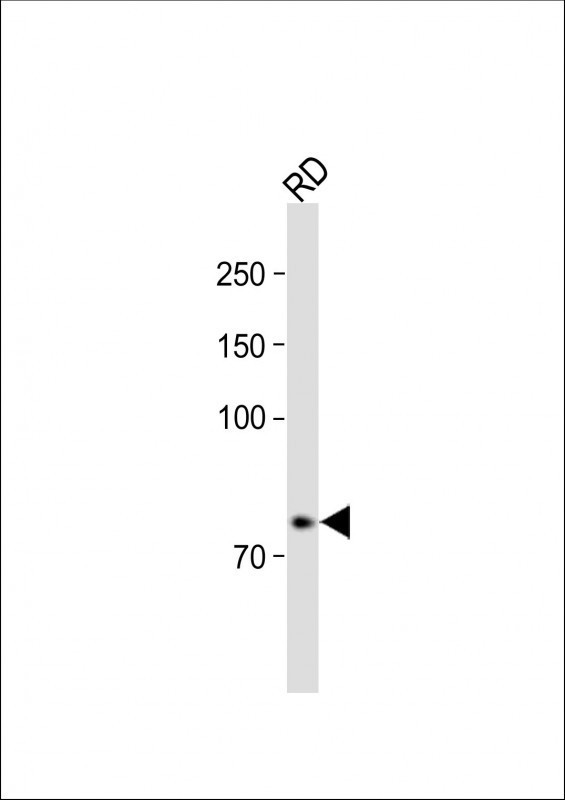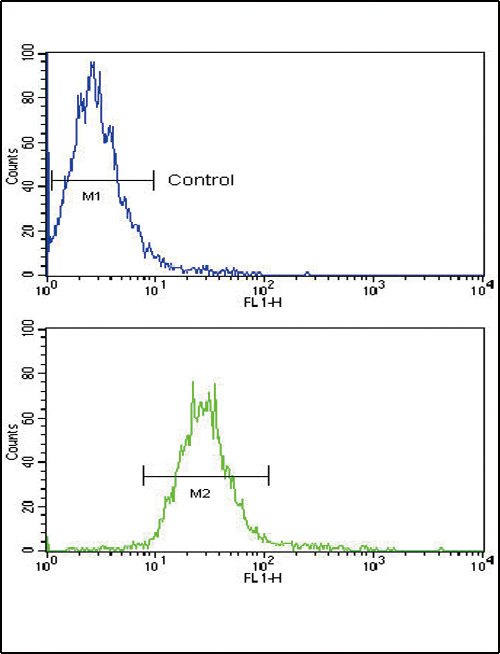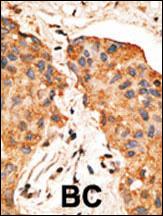NRG1 Antibody (Center)
Purified Rabbit Polyclonal Antibody (Pab)
- 产品详情
- 文献引用 : 2
- 实验流程
- 背景知识
Application
| WB, IHC-P, FC, E |
|---|---|
| Primary Accession | Q02297 |
| Reactivity | Human |
| Host | Rabbit |
| Clonality | Polyclonal |
| Isotype | Rabbit IgG |
| Calculated MW | 70392 Da |
| Antigen Region | 198-229 aa |
| Gene ID | 3084 |
|---|---|
| Other Names | Pro-neuregulin-1, membrane-bound isoform, Pro-NRG1, Neuregulin-1, Acetylcholine receptor-inducing activity, ARIA, Breast cancer cell differentiation factor p45, Glial growth factor, Heregulin, HRG, Neu differentiation factor, Sensory and motor neuron-derived factor, NRG1, GGF, HGL, HRGA, NDF, SMDF |
| Target/Specificity | This NRG1 antibody is generated from rabbits immunized with a KLH conjugated synthetic peptide between 198-229 amino acids from the Central region of human NRG1. |
| Dilution | WB~~1:1000 IHC-P~~1:100~500 FC~~1:10~50 E~~Use at an assay dependent concentration. |
| Format | Purified polyclonal antibody supplied in PBS with 0.05% (V/V) Proclin 300. This antibody is purified through a protein A column, followed by peptide affinity purification. |
| Storage | Maintain refrigerated at 2-8°C for up to 2 weeks. For long term storage store at -20°C in small aliquots to prevent freeze-thaw cycles. |
| Precautions | NRG1 Antibody (Center) is for research use only and not for use in diagnostic or therapeutic procedures. |
| Name | NRG1 |
|---|---|
| Synonyms | GGF, HGL, HRGA, NDF, SMDF |
| Function | Direct ligand for ERBB3 and ERBB4 tyrosine kinase receptors. Concomitantly recruits ERBB1 and ERBB2 coreceptors, resulting in ligand-stimulated tyrosine phosphorylation and activation of the ERBB receptors. The multiple isoforms perform diverse functions such as inducing growth and differentiation of epithelial, glial, neuronal, and skeletal muscle cells; inducing expression of acetylcholine receptor in synaptic vesicles during the formation of the neuromuscular junction; stimulating lobuloalveolar budding and milk production in the mammary gland and inducing differentiation of mammary tumor cells; stimulating Schwann cell proliferation; implication in the development of the myocardium such as trabeculation of the developing heart. Isoform 10 may play a role in motor and sensory neuron development. Binds to ERBB4 (PubMed:10867024, PubMed:7902537). Binds to ERBB3 (PubMed:20682778). Acts as a ligand for integrins and binds (via EGF domain) to integrins ITGAV:ITGB3 or ITGA6:ITGB4. Its binding to integrins and subsequent ternary complex formation with integrins and ERRB3 are essential for NRG1-ERBB signaling. Induces the phosphorylation and activation of MAPK3/ERK1, MAPK1/ERK2 and AKT1 (PubMed:20682778). Ligand-dependent ERBB4 endocytosis is essential for the NRG1-mediated activation of these kinases in neurons (By similarity). |
| Cellular Location | [Pro-neuregulin-1, membrane-bound isoform]: Cell membrane; Single-pass type I membrane protein. Note=Does not seem to be active [Isoform 8]: Nucleus. Note=May be nuclear. [Isoform 10]: Membrane; Single-pass type I membrane protein. Note=May possess an internal uncleaved signal sequence |
| Tissue Location | Type I isoforms are the predominant forms expressed in the endocardium. Isoform alpha is expressed in breast, ovary, testis, prostate, heart, skeletal muscle, lung, placenta liver, kidney, salivary gland, small intestine and brain, but not in uterus, stomach, pancreas, and spleen. Isoform 3 is the predominant form in mesenchymal cells and in non-neuronal organs, whereas isoform 6 is the major neuronal form. Isoform 8 is expressed in spinal cord and brain. Isoform 9 is the major form in skeletal muscle cells; in the nervous system it is expressed in spinal cord and brain. Also detected in adult heart, placenta, lung, liver, kidney, and pancreas. Isoform 10 is expressed in nervous system: spinal cord motor neurons, dorsal root ganglion neurons, and brain. Predominant isoform expressed in sensory and motor neurons. Not detected in adult heart, placenta, lung, liver, skeletal muscle, kidney, and pancreas. Not expressed in fetal lung, liver and kidney. Type IV isoforms are brain-specific |
For Research Use Only. Not For Use In Diagnostic Procedures.

Provided below are standard protocols that you may find useful for product applications.
BACKGROUND
Neuregulin 1 (NRG1) was originally identified as a 44-kD glycoprotein that interacts with the NEU/ERBB2 receptor tyrosine kinase to increase its phosphorylation on tyrosine residues. It is known that an extraordinary variety of different isoforms are produced from the NRG1 gene by alternative splicing. These isoforms include heregulins (HRGs), glial growth factors (GGFs) and sensory and motor neuron-derived factor (SMDF). They are tissue-specifically expressed and differ significantly in their structure. The HRG isoforms all contain immunoglobulin (Ig) and epidermal growth factor-like (EGF-like) domains. GGF and GGF2 isoforms contain a kringle-like sequence plus Ig and EGF-like domains; and the SMDF isoform shares only the EGF-like domain with other isoforms. The receptors for all NRG1 isoforms are the ERBB family of tyrosine kinase transmembrane receptors. Through interaction with ERBB receptors, NRG1 isoforms induce the growth and differentiation of epithelial, neuronal, glial, and other types of cells.
REFERENCES
Stove, C., et al., J. Invest. Dermatol. 121(4):802-812 (2003).
Adelaide, J., et al., Genes Chromosomes Cancer 37(4):333-345 (2003).
Ritch, P.A., et al., J. Biol. Chem. 278(23):20971-20978 (2003).
Vermeer, P.D., et al., Nature 422(6929):322-326 (2003).
Atlas, E., et al., Mol. Cancer Res. 1(3):165-175 (2003).
终于等到您。ABCEPTA(百远生物)抗体产品。
点击下方“我要评价 ”按钮提交您的反馈信息,您的反馈和评价是我们最宝贵的财富之一,
我们将在1-3个工作日内处理您的反馈信息。
如有疑问,联系:0512-88856768 tech-china@abcepta.com.






















 癌症的基本特征包括细胞增殖、血管生成、迁移、凋亡逃避机制和细胞永生等。找到癌症发生过程中这些通路的关键标记物和对应的抗体用于检测至关重要。
癌症的基本特征包括细胞增殖、血管生成、迁移、凋亡逃避机制和细胞永生等。找到癌症发生过程中这些通路的关键标记物和对应的抗体用于检测至关重要。 为您推荐一个泛素化位点预测神器——泛素化分析工具,可以为您的蛋白的泛素化位点作出预测和评分。
为您推荐一个泛素化位点预测神器——泛素化分析工具,可以为您的蛋白的泛素化位点作出预测和评分。 细胞自噬受体图形绘图工具为你的蛋白的细胞受体结合位点作出预测和评分,识别结合到自噬通路中的蛋白是非常重要的,便于让我们理解自噬在正常生理、病理过程中的作用,如发育、细胞分化、神经退化性疾病、压力条件下、感染和癌症。
细胞自噬受体图形绘图工具为你的蛋白的细胞受体结合位点作出预测和评分,识别结合到自噬通路中的蛋白是非常重要的,便于让我们理解自噬在正常生理、病理过程中的作用,如发育、细胞分化、神经退化性疾病、压力条件下、感染和癌症。









